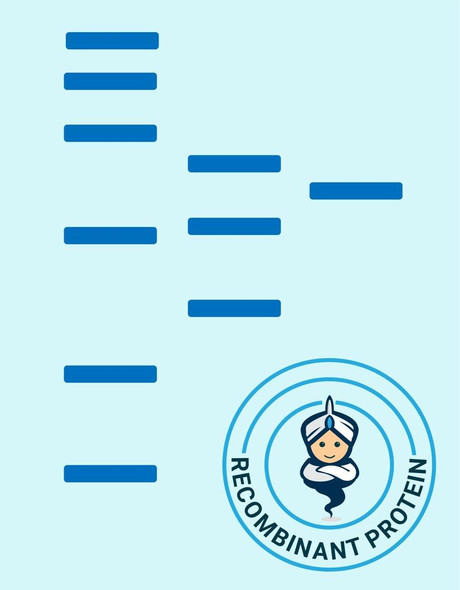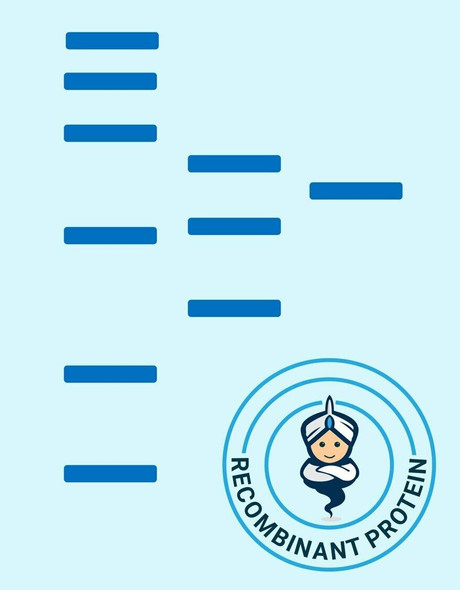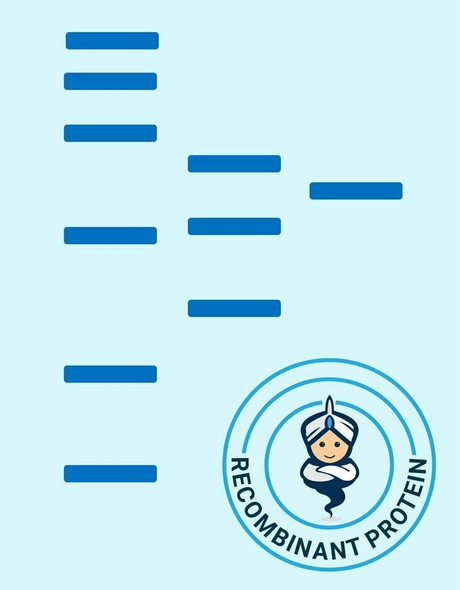Human NRG1 Recombinant Protein (RPPB0789)
- SKU:
- RPPB0789
- Product type:
- Recombinant Protein
- Size:
- 50ug
- Species:
- Human
- Target:
- NRG1
- Synonyms:
- Neuregulin-1
- NRG1
- GGF
- HGL
- Source:
- Escherichia Coli
- Uniprot:
- Q02297
Description
| Product Name: | Human NRG1 Recombinant Protein |
| Product Code: | RPPB0789 |
| Size: | 50µg |
| Species: | Human |
| Target: | NRG1 |
| Synonyms: | Neuregulin-1, NRG1, GGF, HGL, HRGA, NDF, SMDF, HRG, ARIA, GGF2, HRG1. |
| Source: | Escherichia Coli |
| Physical Appearance: | Sterile Filtered White lyophilized (freeze-dried) powder. |
| Formulation: | Lyophilized from a 0.2µm filtered solution in PBS, pH 7.4. |
| Solubility: | It is recommended to reconstitute the lyophilized NRG1 in sterile 18M?-cm H2O not less than 100µg/ml, which can then be further diluted to other aqueous solutions. |
| Stability: | Lyophilized NRG1 although stable at room temperature for 3 weeks, should be stored desiccated below -18°C. Upon reconstitution Heregulin should be stored at 4°C between 2-7 days and for future use below -18°C.Please prevent freeze-thaw cycles. |
| Purity: | Greater than 96.0% as determined by:(a) Analysis by RP-HPLC.(b) Analysis by SDS-PAGE. |
| Amino Acid Sequence: | SHLVKCAEKEKTFCVNGGECFMVKDLSNPSRYLCKCPNEFTGDRCQNYVMASFYKAEELYQ |
| Biological Activity: | The ED50 as determined by a cell proliferation assay using serum free human MCF-7 cells is less than 50ng/ml, corresponding to a specific activity of > 2.0 × 104 IU/mg. |
Neuregulin is a signaling protein for ErbB2/ErbB4 receptor heterodimers on the cardiac muscle cells, playing an important role in heart structure and function through inducing ErbB2/ErbB4 receptor phosphorylation and cardiomyocyte differentiation. Research on molecular level discovered that neuregulin recombinant could make disturbed myocardial cell structure into order and strengthen the connection between myocardial cells by intercalated discs re-organization. Pharmacodynamic experiments in animals showed that neuregulin (NRG1) recombinant can reduce the degree of damage on myocardial cells caused by ischemia, hypoxia and viral infection.
Recombinant Human Neuregulin-1 beta 2 produced in E.Coli is a single, non-glycosylated, polypeptide chain containing 61 amino acids and having a total molecular mass of 7.0kDa. NRG-1 is purified by proprietary chromatographic techniques.
| UniProt Protein Function: | NRG1: Direct ligand for ERBB3 and ERBB4 tyrosine kinase receptors. Concomitantly recruits ERBB1 and ERBB2 coreceptors, resulting in ligand-stimulated tyrosine phosphorylation and activation of the ERBB receptors. The multiple isoforms perform diverse functions such as inducing growth and differentiation of epithelial, glial, neuronal, and skeletal muscle cells; inducing expression of acetylcholine receptor in synaptic vesicles during the formation of the neuromuscular junction; stimulating lobuloalveolar budding and milk production in the mammary gland and inducing differentiation of mammary tumor cells; stimulating Schwann cell proliferation; implication in the development of the myocardium such as trabeculation of the developing heart. Isoform 10 may play a role in motor and sensory neuron development. The cytoplasmic domain interacts with the LIM domain region of LIMK1. Interacts with ERBB3 and ERBB4. Type I isoforms are the predominant forms expressed in the endocardium. Isoform alpha is expressed in breast, ovary, testis, prostate, heart, skeletal muscle, lung, placenta liver, kidney, salivary gland, small intestine and brain, but not in uterus, stomach, pancreas, and spleen. Isoform 3 is the predominant form in mesenchymal cells and in non-neuronal organs, whereas isoform 6 is the major neuronal form. Isoform 8 is expressed in spinal cord and brain. Isoform 9 is the major form in skeletal muscle cells; in the nervous system it is expressed in spinal cord and brain. Also detected in adult heart, placenta, lung, liver, kidney, and pancreas. Isoform 10 is expressed in nervous system: spinal cord motor neurons, dorsal root ganglion neurons, and brain. Predominant isoform expressed in sensory and motor neurons. Not detected in adult heart, placenta, lung, liver, skeletal muscle, kidney, and pancreas. Not expressed in fetal lung, liver and kidney. Type IV isoforms are brain-specific. Belongs to the neuregulin family. 10 isoforms of the human protein are produced by alternative splicing. |
| UniProt Protein Details: | Protein type:Cell development/differentiation; Membrane protein, integral; Ligand, receptor tyrosine kinase; Cytokine; Motility/polarity/chemotaxis Chromosomal Location of Human Ortholog: 8p12 Cellular Component: extracellular space; membrane; axon; integral to plasma membrane; apical plasma membrane; cytoplasm; extracellular region; neuromuscular junction; nucleus Molecular Function:ErbB-2 class receptor binding; protein binding; transmembrane receptor protein tyrosine kinase activator activity; growth factor activity; ErbB-3 class receptor binding; cytokine activity; transcription cofactor activity; protein tyrosine kinase activator activity; receptor tyrosine kinase binding; receptor binding Biological Process: regulation of protein heterodimerization activity; transmembrane receptor protein tyrosine kinase activation (dimerization); positive regulation of cell adhesion; neural crest cell development; wound healing; nerve growth factor receptor signaling pathway; cellular protein complex disassembly; cell morphogenesis; ventricular cardiac muscle cell differentiation; locomotory behavior; positive regulation of striated muscle cell differentiation; cardiac muscle cell differentiation; synaptogenesis; mammary gland development; cell communication; positive regulation of cardiac muscle cell proliferation; epidermal growth factor receptor signaling pathway; nervous system development; cell migration; phosphoinositide-mediated signaling; fibroblast growth factor receptor signaling pathway; neurotransmitter receptor metabolic process; regulation of protein homodimerization activity; MAPKKK cascade; neuron fate commitment; positive regulation of cell growth; peripheral nervous system development; positive regulation of protein kinase B signaling cascade; cell proliferation; embryonic development; glial cell fate commitment; innate immune response; negative regulation of secretion; positive regulation of Ras protein signal transduction; negative regulation of protein catabolic process; negative regulation of transcription, DNA-dependent; transmembrane receptor protein tyrosine kinase signaling pathway Disease: Schizophrenia 6 |
| NCBI Summary: | The protein encoded by this gene is a membrane glycoprotein that that mediates cell-cell signaling and plays a critical role in the growth and development of multiple organ systems. An extraordinary variety of different isoforms are produced from this gene through alternative promoter usage and splicing. These isoforms are expressed in a tissue-specific manner and differ significantly in their structure, and are classified as types I, II, III, IV, V and VI. Dysregulation of this gene has been linked to diseases such as cancer, schizophrenia, and bipolar disorder (BPD). [provided by RefSeq, Jun 2014] |
| UniProt Code: | Q02297 |
| NCBI GenInfo Identifier: | 9297018 |
| NCBI Gene ID: | 3084 |
| NCBI Accession: | Q02297.3 |
| UniProt Secondary Accession: | Q02297,O14667, P98202, Q02298, Q02299, Q07110, Q07111 A5YAK4, A5YAK5, A8K1L2, B7Z4Z3, E9PHH4, |
| UniProt Related Accession: | Q02297 |
| Molecular Weight: | |
| NCBI Full Name: | Pro-neuregulin-1, membrane-bound isoform |
| NCBI Synonym Full Names: | neuregulin 1 |
| NCBI Official Symbol: | NRG1 |
| NCBI Official Synonym Symbols: | GGF; HGL; HRG; NDF; ARIA; GGF2; HRG1; HRGA; SMDF; MST131; MSTP131; NRG1-IT2 |
| NCBI Protein Information: | pro-neuregulin-1, membrane-bound isoform; pro-NRG1; glial growth factor; neu differentiation factor; sensory and motor neuron derived factor; heregulin, alpha (45kD, ERBB2 p185-activator) |
| UniProt Protein Name: | Pro-neuregulin-1, membrane-bound isoform |
| UniProt Synonym Protein Names: | Acetylcholine receptor-inducing activity; ARIA; Breast cancer cell differentiation factor p45; Glial growth factor; Heregulin; HRG; Neu differentiation factor; Sensory and motor neuron-derived factor |
| Protein Family: | Pro-neuregulin |
| UniProt Gene Name: | NRG1 |
| UniProt Entry Name: | NRG1_HUMAN |









